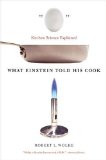Food and science go hand in hand. Chemistry and physics help explain what happens when heat (or cold, or acid, etc.) is applied to food. Biology helps describe the ingredients we consume. Nutritional science helps us understand how to meet the body’s needs. Yet so many folks, when they hear something that sounds vaguely scientific or technical, immediately tune it out assuming they won’t be able to understand it. For those people (as well as us devout food-nerds) I present What Einstein Told His Cook: Kitchen Science Explained


Once I opened the book, I found it difficult to put down. The information contained within is illuminating and would be helpful to even the most self-proclaimed unscientific of cooks. And did I mention that our beloved chemistry professor has a wonderful sense of humor? I found myself chuckling out loud as I was reading the book. Here’s one line of commentary in his answer to what keeps unrefrigerated hams from spoiling:
In addition to the excellent discussion on all manner of culinary topics, Mr. Wolke provides us with illustrative recipes as well. In the segment of the Turf and Surf chapter revolving around food preservation, he presents a recipe for gravlax (cured salmon). In his The Fat of the Land chapter, he provides a recipe for Potatoes Anna (nothing more than salt, pepper, potatoes, and clarified butter baked in a cast iron pan to golden brown perfection).
The recipes are interesting, but it’s certainly the science that I keep going back for. While he seems to take particular pride in debunking kitchen myths (contrary to popular belief, the salt in the pasta water does NOT appreciably decrease pasta cooking time – however, it does make the pasta taste better), his clear aim is to educate. Don’t be put off by the occasional chart or molecular diagram. The information is accessible, and taken into consideration when in the kitchen, will help even the best cooks improve their craft.
I hear-tell that there’s a widely-held perception that science books are perhaps a bit on the dry side. While I feel I’ve supplied sufficient evidence to the contrary for this particular book, a highly entertaining excerpt can be found at Robert Wolke’s website if you’d like further proof. Partial archives of his biweekly food science column for the Washington Post can be examined as well.
I encourage any serious home cook to at least take a look at the online resources mentioned above. And of course, I highly recommend this book. (In fact, there’s a successor to it called What Einstein Told His Cook, The Sequel: Further Adventures in Kitchen Science that I’m now quite keen to get my hands on). In the words of the author himself, “May you derive as much pleasure from understanding your food as from eating it.”